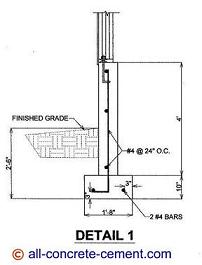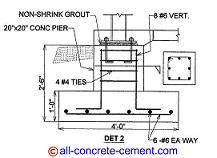|
[?]Subscribe To This Site
|
Spread FootingAs the name implies, spread footing is designed to spread out or evenly distribute the load to a wider area as it enters the ground. Pier footing and post footing are different from spread footings in that they are not flared at the bottom to give them more carrying capacity. The wider area that spread concrete footing has at the bottom greatly increases the carrying capacity of the ground providing more stability to the structure. The concrete footing details below, spot footing detail 2 and continuous footing detail 1 are examples of spread cement footings. By widening the contact area between spread cement footings and the soil, it greatly increases it's load carrying capacity. For example, a 12 inch diameter pier footing has 113 square inches contact area with the ground, compared to 2304 square inches contact area of the spot footing shown in detail 2. For a 5000 pounds load, detail 2 will exerts 2.17 psi of pressure on the soil versus 44.2 psi, 22 times greater by the 12 inch diameter pier.

Details 1 and 2 are the most commonly used spreading footers details. Vast majority of both commercial and residential structures use combination of these two details. The continuous footing detail 1 is mainly used to support foundation walls, bearing walls, shear walls, etc. These continuous footings can also be found at braced frames which is a major element in the lateral supporting element of a structure. These footings more often than not are found at the perimeter of a house or building. The spot footings Detail 2 is mainly used to support columns or posts for both residential and commercial structures. Spot footings take the point loads from a column and spread them to a wider area thereby increasing the ability of the soil to carry more weight also stabilizes the structure. Where moment framed structure is used, spot footings can be reinforced to resist moment forces generated by wind load or earthquake load. These are usually shown with layers of reinforcements on top of the footings. The intend is when the footing is subjected to uplift load, the top face of the footing is experiencing upward pull which will put the top of the footing in tension, thus the top reinforcements. For more information on footings, click here Back to the top Go to From spread footing to all-concrete-cement.com Your Question or CommentWelcome! |
|





